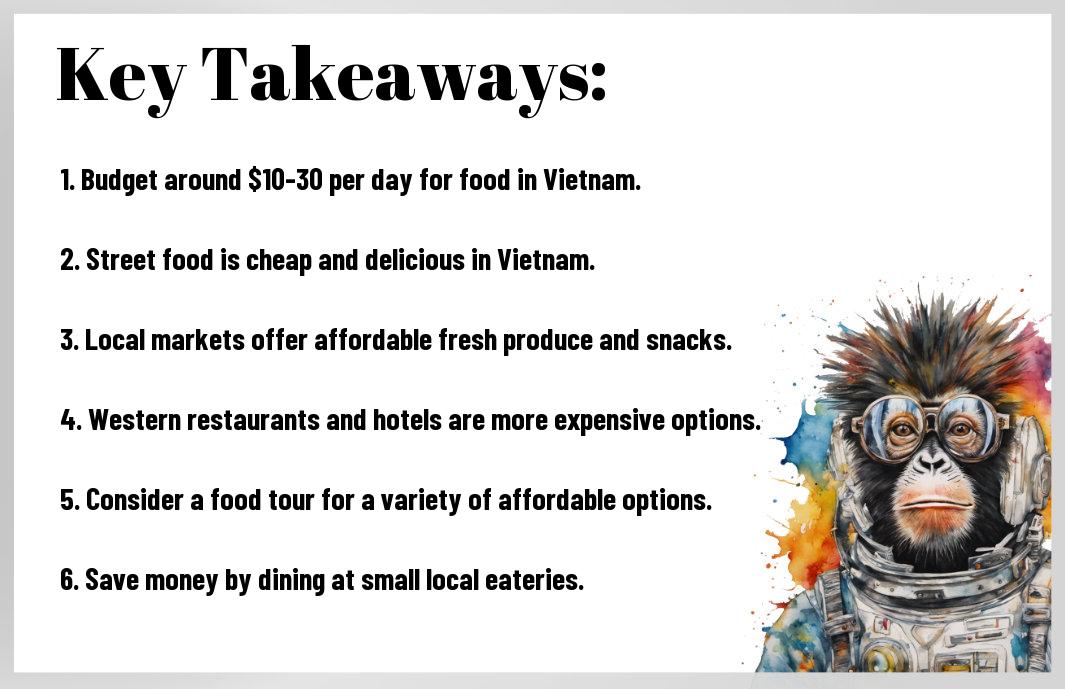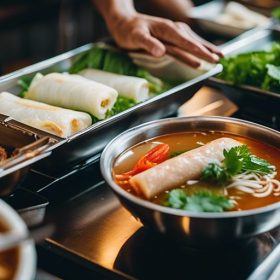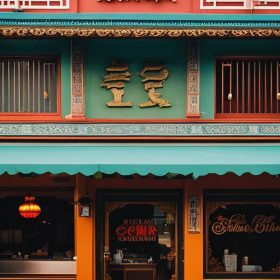Running low on budget and wondering how much you should set aside for food expenses during your time in Vietnam? You have come to the right place. Vietnam is a paradise for food lovers, offering an array of delicious cuisine at affordable prices. From street food stalls to upscale restaurants, the options are plentiful and varied. But it’s important to manage your budget wisely to truly make the most of your food experience in Vietnam. Let’s delve into the details and help you plan your spending effectively.
Key Takeaways:
- Food Costs Vary: The amount you should budget for food in Vietnam will depend on various factors including location, dining preferences, and your individual eating habits.
- Budget for Street Food: Vietnam is known for its delicious and affordable street food, so be sure to allocate a portion of your budget for these local culinary experiences.
- Restaurant Dining: While street food is a major part of the culinary scene, budget travelers should also plan for some sit-down restaurant meals, which can be more expensive but still very affordable compared to Western prices.
- Market Shopping: Consider visiting local markets for fresh produce and snacks. Budgeting for this allows you to experience the culture and save money on meals.
- Be Mindful of Tourist Areas: Food prices in popular tourist areas can be higher than in less frequented areas, so adjust your budget accordingly if you plan to spend time in these locations.
- Budget for Beverages: Don’t forget to allocate funds for drinks, including water, local beverages, and the occasional alcoholic drink if desired.
- Flexible Budgeting: It’s important to be flexible with your budget and be open to trying a mix of street food, restaurants, and market finds to make the most of your culinary experience in Vietnam.
Daily Food Budget Basics
Even though Vietnam is known for its delicious and affordable food, it’s important to budget wisely to make the most of your dining experiences. Your daily food budget in Vietnam will depend on your eating habits and preferences, but a general rule of thumb is to budget around $10-15 per day for food. This budget will allow you to enjoy a variety of local cuisine without breaking the bank.
Street Food and Local Eateries
When it comes to budget-friendly dining options in Vietnam, street food and local eateries are your best bet. You can find delicious and authentic dishes for as little as $1-2 per meal. From steaming bowls of pho to fresh spring rolls, the vibrant street food scene in Vietnam offers a wide array of affordable and flavorful options. Just be sure to choose busy stalls with a steady stream of customers to ensure freshness and hygiene.
Restaurants and Mid-Range Dining
For a slightly more upscale dining experience, you can expect to spend around $5-10 per meal at mid-range restaurants. These establishments offer a more comfortable setting and a wider menu selection, including both traditional Vietnamese dishes and international cuisine. While the prices here are still very reasonable, you may want to reserve these dining experiences for special occasions or when you’re craving a sit-down meal.
Regional Price Variations
To truly understand how much budget you need for food in Vietnam, it’s important to consider the regional price variations. The cost of food can vary greatly depending on whether you are in Northern, Central, or Southern Vietnam. Factors such as availability of certain ingredients, local cuisine, and economic development all contribute to these variations.
Northern Vietnam Food Expenses
In Northern Vietnam, the cost of food tends to be slightly higher compared to the other regions. This is partly due to the colder climate and the availability of certain ingredients. Local dishes such as pho and bun cha are popular in this region and are a must-try. You can expect to spend around $2-5 for a simple meal in a local eatery, while a meal at a mid-range restaurant may cost you around $10-20. Be cautious of street food vendors in terms of hygiene and cleanliness.
Southern Vietnam Food Expenses
Southern Vietnam offers a more affordable food scene compared to the North. This region is known for its vibrant street food culture, where you can find delicious and cheap meals at every corner. A bowl of pho or a banh mi sandwich from a street vendor may only cost you around $1-2. Dining at local restaurants can range from $5-15, depending on the location and type of cuisine. Be mindful of the hygiene standards at street food stalls, and always ensure that your food is cooked thoroughly.
Saving Money on Food
Despite the growing popularity of Vietnamese cuisine, you may want to be mindful of your budget when dining out. Fortunately, there are several ways you can save money on food during your visit to Vietnam.
Tips for Budget-Friendly Eating
When dining out in Vietnam, you can keep your expenses in check by opting for local eateries rather than upscale restaurants. Additionally, choosing street food vendors and food stalls can offer you an authentic culinary experience at a fraction of the cost. Another useful tip is to eat at the same places as the locals. This way, you can find delicious meals at affordable prices while experiencing the true flavors of Vietnam.
- Local eateries over upscale restaurants
- Street food vendors and food stalls
- Eat at the same places as the locals
Recognizing these tips and incorporating them into your dining choices can help you save money on food while indulging in the local cuisine.
Price Bargaining and Local Shopping
Another way to save money on food in Vietnam is by bargaining for the best prices at local markets and negotiating with street vendors. Taking advantage of local marketplaces allows you to purchase fresh produce and ingredients at lower prices, which can be used for preparing your own meals or snacks at your accommodation. This approach not only saves you money but also gives you the opportunity to explore the vibrant local food culture.
Conclusion
Drawing together all the aspects of budgeting for food in Vietnam, you can see that it is possible to enjoy a diverse and delicious cuisine without breaking the bank. By accounting for your dining habits, acknowledging the prices at different types of establishments, and being willing to indulge in local street food, you can comfortably budget around 10-15 USD per day on food while visiting Vietnam. Keep in mind that this is just a general guideline and can vary depending on your personal preferences and tastes. With a little planning and a sense of adventure, you can savor the flavors of Vietnam without overspending.
FAQ
Q: What is the average budget for food in Vietnam?
A: The average budget for food in Vietnam varies depending on your dining preferences and location. However, a budget of $5-10 per day for street food and local eateries, and $15-25 per day for mid-range restaurants should suffice for most travelers.
Q: What type of meals can I expect within the budget range?
A: Within the budget range, you can expect to enjoy a variety of local dishes such as pho, banh mi, spring rolls, and rice or noodle dishes. You may also enjoy fresh tropical fruits and Vietnamese coffee within your budget.
Q: Are there affordable dining options for travelers with dietary restrictions?
A: Vietnam offers a wide range of dining options for travelers with dietary restrictions. You can find vegetarian, vegan, and gluten-free options at both local eateries and mid-range restaurants.
Q: Are there any tips for saving money on food in Vietnam?
A: To save money on food in Vietnam, consider eating at local markets, street food stalls, and family-owned eateries. Additionally, opting for local beer or fresh coconut water instead of imported drinks can help keep your expenses low.
Q: Can I safely eat street food within my budget?
A: Yes, street food is a safe and affordable option in Vietnam. Be sure to choose vendors with high turnover, as this indicates fresh and popular food. Also, consider checking for cleanliness and proper preparation of the food.
Q: Should I tip at restaurants in Vietnam?
A: Tipping is not expected at most restaurants in Vietnam. However, if you receive exceptional service, you can leave a small gratuity as a token of appreciation. It’s not a common practice, but it’s always appreciated.
Q: How can I balance my budget with occasional splurges on dining experiences?
A: While sticking to a budget is important, you can still enjoy occasional splurges on dining experiences in Vietnam. Consider saving money on other expenses such as accommodation or transportation to allocate more budget for a luxurious dining experience at a high-end restaurant. This way, you can balance your budget while indulging in memorable culinary experiences.

Cuong Nguyen is a talented writer and experienced waitress at Vietnampalace.net, a renowned Vietnamese restaurant that offers an extensive menu of authentic Vietnamese cuisine. With a background in the competition of Vietnamese cuisine, Cuong brings a wealth of knowledge and expertise to the dining experience. From delicious pho dishes to fresh spring rolls, Cuong ensures that every meal is made with the freshest ingredients and authentic flavors.With exceptional service and a friendly atmosphere, Cuong takes pride in providing a memorable dining experience for every customer.
Whether you’re a vegetarian looking for options or a meat lover craving the flavors of traditional Vietnamese dishes, Cuong guarantees a delightful culinary adventure. So, visit Vietnampalace.net and let Cuong guide you through the tantalizing world of Vietnamese cuisine.



